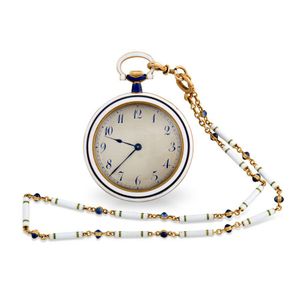18ct Gold Enamel Watch with Matching Chain
You must be a subscriber, and be logged in to view price and dealer details.
Subscribe Now to view actual auction price for this item
When you subscribe, you have the option of setting the currency in which to display prices to $Au, $US, $NZ or Stg.
- Guilloche - A form of classical decoration consisting of a repeating ornament of interlacing curved bands, sometimes forming circles, and further decorated with rosettes or other flower forms.
The name is derived from the inventor, French engineer Guillot, who invented a mechanical method of inscribing fine repeating patterns on to metallic surfaces.
On enamelled items with guilloche decoration, the surface is firstly engraved with the repeating pattern, and then covered with several layers of enamel, each of which is fired.
Where the item has not been enamelled the form of decoration is usually called "engine turned". - Circa - A Latin term meaning 'about', often used in the antique trade to give an approximate date for the piece, usually considered to be five years on either side of the circa year. Thus, circa 1900 means the piece was made about 1900, probably between 1895 and 1905. The expression is sometimes abbreviated to c.1900.
- Bezel - On a clock or watch, the bezel is the metal frame into which the watch or clock glass is fitted. In clocks, the bezel may include a hinge and a flange, in effect a door to the face of the clock. In jewellery the bezel is a band of metal with a projecting lip that holds the gemstone in its setting.
- Movement - The technical name for the workings of a clock or watch, and does not include the dial or case.
This item has been included into following indexes:
Visually similar items

Antique open face gold plated pocket watch no 644055 moon Dennison watch case Co

A gentleman's silver open face pocket watch, A. Lange & Sohne, Glashutte, circa late 1,800's. 53 mm. Case number 39596. Movement number 39596. Boxed.

A silver gents pocket watch c.1900. Stamped 935. No makers mark. Case number: 301966. Weight: 120.1g

A ladies vintage gold Rolex wristwatch, 9ct yellow gold, case and movement marked Rolex, with small round case and manual movement, white enamel dial, black Roman numerals, fitted with a generic Handley 9ct rolled gold bracelet with fold over clasp, comple
